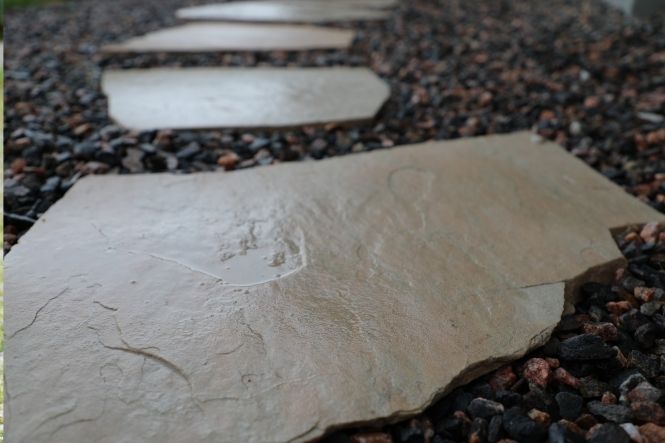A garden path made from stepping stones is one where the blocks, stones or flags that make up the path are laid down individually with gaps in between them. You need to take a step to get from one to the next, hence the name ‘stepping stones’. And although they were originally used as a way to cross rivers where there was no bridge or ford, in gardens they are more normally used as a simple way of laying a path across a lawn, perhaps from a patio to a flower bed.
Using Stepping Stones in a Garden
Apart from choosing stepping stones because you like the way they look, you might think about them if your lawn undulates quite a lot. Because the stones are separate from each other you can be less fastidious about having them perfectly level and smoothing out the gradient. Drainage is not an issue as the water escapes into the area around each stone.
Think about the way that you use your garden before plumping for stepping stones, though. For example, if you need to get a wheelbarrow down to a part of a garden fairly regularly, you might be better off with a more solid and level path with no gaps between the stones (see Options For Paths and Steps on this site).
Stepping Stone Materials
There’s an incredible choice of stepping stone material available. Although there are some that are purpose built, pretty much any paving stone or block can be used. The key point is not to use brick, block or stone that’s designed for building walls; they will not stand the constant soaking and will crack apart after a couple of frosts.
Stepping stones can be laid in turf, across Gravel or another loose surface, but the main point is to make sure they are solid. People will walk on them and expect them to be secure, so if they wobble it can lead to a fall, particularly with the elderly or children.
Laying the Stones in Your Garden
You might be tempted to simply place the stones on the lawn, but it would be safer and more long-lasting to fix them properly. Although the techniques used to lay and secure stepping stones are no different to those that you’d use if you were Laying Blocks or flagstones for a patio, more attention needs to be paid to preventing slippage from side to side as there is no lateral support from adjacent stones.
If slippage is likely to be a problem, it can be alleviated by laying a bed of concrete beneath each stone which is 5-10cm larger than the stone all round. Then push the stone down into the concrete some way so that it spreads around the lower edge of the stone to hold it in place laterally.
If you’re laying a long stepping stone path, it might be worth removing the turf and Laying A Continuous Bed Of Concrete for the whole path. Once the stones are laid and the concrete has gone off a little, the turf can be re-laid around the stones and cut to fit. This might be easier than digging a separate hole for each stone, but remember to make gaps in the concrete bed between each stone for drainage and to allow nutrients to reach the grass.
Get Your Separation Distances Right
Finally, make sure that the distance between each stone (the ‘separation distance’) is set so that stepping along them feels natural. If your stepping stone path is very short, perhaps just a couple of flags to provide a dry path from a patio to a driveway, then this is less important.
The actual gap depends on the length of the stones and, of course, the stride of the person walking on them. The best way to get this right is to step the course out first and mark the proposed stone placements with pegs. Then just lay the stones down on top of the lawn to test walk it again. Half an hour spent on this now will avoid a lifetime of irritation every time you walk across the lawn.

